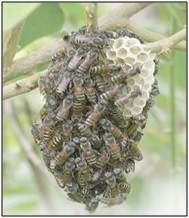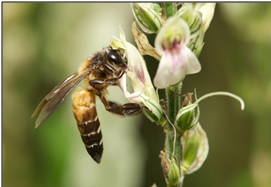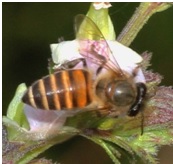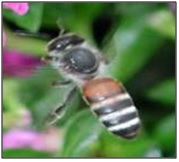Envis Centre, Ministry of Environment & Forest, Govt. of India
Printed Date: Wednesday, September 17, 2025
Honey Bees - The Greatest Pollinators
Bees are part of the biodiversity on which we all depend for our survival. Bees are some of the most important pollinators. They provide high quality food honey, royal jelly and pollen and other products such as beeswax, propolis and honey bee venom. Bees are also important in terms of sustainable agriculture and creating rural jobs. By pollinating, they increase agricultural production, thus maintaining diversity and variety in our fields and on our plates. Honey is produced by honey bees belonging to the genus Apis.


|
Scientific Classification
|
|
Kingdom
|
Animalia
|
|
Phylum
|
Arthropoda
|
|
Class
|
Insecta
|
|
Order
|
Hymenoptera
|
|
Family
|
Apidae
|
|
Subgenus
|
Megapis
|
|
Species
|
A.dorsata
|
|
|
Apis dorsata are endemic to the Indian subcontinent as they are tropical. Rock bees can be found in China, Malaysia, Indonesia, India, Pakistan, and Sri Lanka. The comb is approximately 1 metre across. The rock bees generally live on tall trees in thick timberlands. But, hives of rock bees are also sometimes found on buildings. Rock bees stay at a place for 3 to 4 months and change their settlement depending on stormy or dry seasons. These are the wild variety and are called vanthen and parathekkan in local parlance. They are the largest in the species. They construct single comb in open about 6 feet long and 3 feet deep. Rock bees are ferocious and difficult to rear. They produce about 36 Kg honey per comb per year.
|
Indian hive bee (Apis cerana indica)
|

|
Scientific Classification
|
|
Kingdom
|
Animalia
|
|
Scientific Name
|
Apis cerana indica
|
|
Phylum
|
Arthropoda
|
|
Class
|
Insecta
|
|
Order
|
Hymenoptera
|
|
Family
|
Apidae
|
|
Subgenus
|
Megapis
|
|
Species
|
A.c.indica
|
|
|
Apis cerana indica are small honey bees found in the forests of southern and south-eastern Aisa. They are the domesticated species; their honey yield is smaller, because they form smaller colonies. They construct multiple parallel combs with an average honey yield of 6-8 per colony. It is one of the important pollinators for coconut palms. Relatively non-aggressive and rarely exhibiting swarming behavior, it is ideal for beekeeping.
|
Sting - less honey bee (Trigona iridipennis )
|

|
Scientific Classification
|
|
Kingdom
|
Animalia
|
|
Scientific Name
|
Trigona iridipennis
|
|
Phylum
|
Arthropoda
|
|
Class
|
Insecta
|
|
Order
|
Hymenoptera
|
|
Family
|
Apidae
|
|
Family
|
Fabaceae
|
|
Genus
|
Trigona
|
|
Species
|
T.iridipennis
|
|
|
They are found in the forests of the tropics which make nests in hollow tree trunks and wall cavities and prefer darkness. They lack sting hence the name “stingless bee” and defend by biting with mandibles. Their small size (2-16 mm) allows them to access varied flowers whose openings are too narrow for nectar and pollen from which the Apis bees cannot forage. They yield 300-400 g of honey. Although it produces far less honey the honey is unique having great medicinal value fetching high price. It is traditionally collected by the tribal communities of Western Ghats. They call this honey as Cheruthen. They build irregular combs of wax and resinous substances in crevices and hollow tree trunks.
|
Dwarf honey bee (Apis florae)
|

|
Scientific Classification
|
|
Kingdom
|
Animalia
|
|
Scientific Name
|
Apis florae
|
|
Class
|
Insecta
|
|
Order
|
Hymenoptera
|
|
Family
|
Apidae
|
|
Genus
|
Apis
|
|
Species
|
A.florea
|
|
|
The dwarf honey bee is another wild honey bee of southern and south-eastern Asia. These bees make exposed single combs build on branches of shrubs and small trees. They are poor honey yielders and yield about 200-900 g of honey per colony. They are not rearable as they frequently change their place. The size of the bees is smallest among four Apis species described and smaller than Indian bee. They distribute only in plains.
Source: